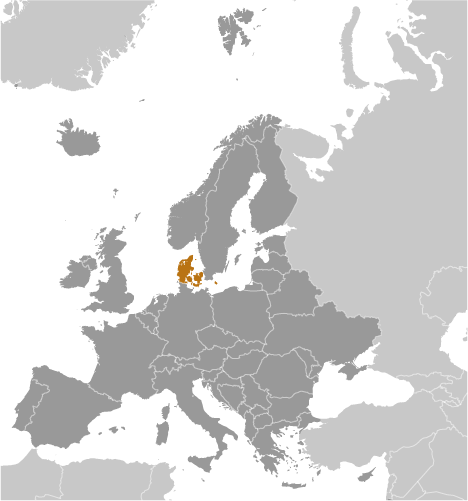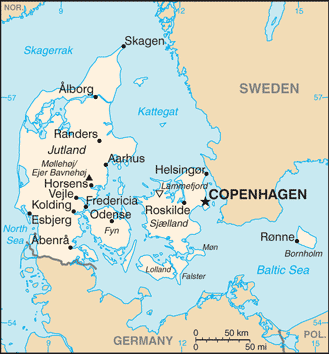
|
|
Advertisements:
EconomyEconomy - overview
This thoroughly modern market economy features a high-tech agricultural sector, state-of-the-art industry with world-leading firms in pharmaceuticals, maritime shipping and renewable energy, and a high dependence on foreign trade. Denmark is a member of the European Union (EU); Danish legislation and regulations conform to EU standards on almost all issues. Danes enjoy among the highest standards of living in the world and the Danish economy is characterized by extensive government welfare measures and an equitable distribution of income. Denmark is a net exporter of food and energy and enjoys a comfortable balance of payments surplus but depends on imports of raw materials for the manufacturing sector. Within the EU, Denmark is among the strongest supporters of trade liberalization. After a long consumption-driven upswing, Denmark's economy began slowing in 2007 with the end of a housing boom. Housing prices dropped markedly in 2008-09 and, following a short respite in 2010, continued to decline in 2011 though at a slower pace. The global financial crisis has exacerbated this cyclical slowdown through increased borrowing costs and lower export demand, consumer confidence, and investment. The global financial crises cut Danish real GDP by 0.8% in 2008 and 5.8% in 2009. Denmark made a modest recovery in 2010 with real GDP growth of 1.3%, in part because of increased government spending; however, the country experienced a technical recession in late 2010-early 2011. Historically low levels of unemployment rose sharply with the recession and have remained at about 6% in 2010-11, based on the national measure, about two-thirds average EU unemployment. An impending decline in the ratio of workers to retirees will be a major long-term issue. Denmark maintained a healthy budget surplus for many years up to 2008, but the budget balance swung into deficit in 2009. In spite of the deficits, the new coalition government plans to deliver a modest stimulus to the economy in 2012. Nonetheless, Denmark's fiscal position remains among the strongest in the EU at 46.5% of GDP in 2011. Despite previously meeting the criteria to join the European Economic and Monetary Union (EMU), so far Denmark has decided not to join, although the Danish krone remains pegged to the euro. Denmark held the EU presidency during the first half of 2012; priorities included promoting a responsible, dynamic, green, and safe Europe, while working to steer Europe out of its euro zone economic crisis. Gdp (purchasing power parity) World Ranking: 54
$209.2 billion (2011 est.)
$207.1 billion (2010 est.) $204.4 billion (2009 est.) Note Data are in 2011 US dollars Gdp (official exchange rate)
$333.2 billion (2011 est.)
Gdp - real growth rate World Ranking: 175
1.1% (2011 est.)
1.3% (2010 est.) -5.8% (2009 est.) Gdp - per capita (ppp) World Ranking: 29
$37,600 (2011 est.)
$37,400 (2010 est.) $37,100 (2009 est.) Note Data are in 2011 US dollars Gdp - composition by sector
Agriculture 4.5%
Industry 19.1% Services 76.4% (2011 est.) Labor force World Ranking: 105
2.853 million (2011 est.)
Labor force - by occupation
Agriculture 2.6%
Industry 20.3% Services 77.1% (2011 est.) Unemployment rate World Ranking: 64
6% (2011 est.)
6% (2010 est.) Population below poverty line
13.4% (2011)
Household income or consumption by percentage share
Lowest 10% 1.9%
Highest 10% 28.7% (2007) Distribution of family income - gini index World Ranking: 133
24.8 (2011 est.)
24.7 (1992) Investment (gross fixed) World Ranking: 122
17.3% of GDP (2011 est.)
Budget
Revenues $118.3 billion
Expenditures $127.5 billion (2011 est.) Taxes and other revenues World Ranking: 63
35.5% of GDP (2011 est.)
Budget surplus (+) or deficit (-) World Ranking: 94
-2.8% of GDP (2011 est.)
Public debt World Ranking: 69
44.2% of GDP (2011 est.)
43.4% of GDP (2010 est.) Note Data cover general government debt, and includes debt instruments issued (or owned) by government entities other than the treasury; the data include treasury debt held by foreign entities; the data include debt issued by subnational entities, as well as intra-governmental debt; intra-governmental debt consists of treasury borrowings from surpluses in the social funds, such as for retirement, medical care, and unemployment; debt instruments for the social funds are not sold at public auctions Inflation rate (consumer prices) World Ranking: 50
2.8% (2011 est.)
2.3% (2010 est.) Central bank discount rate World Ranking: 134
0.75% (31 December 2011 est.)
0.75% (31 December 2010 est.) Commercial bank prime lending rate World Ranking: 164
4.3% (31 December 2011 est.)
4.3% (31 December 2010 est.) Stock of narrow money World Ranking: 26
$134.9 billion (31 December 2011 est.) $156.3 billion (31 December 2010 est.) Stock of broad money World Ranking: 40
$230.8 billion (31 December 2011 est.) $178.4 billion (31 December 2010 est.) Stock of domestic credit World Ranking: 21
$706.6 billion (31 December 2011 est.) $679.9 billion (31 December 2010 est.) Market value of publicly traded shares World Ranking: 32
$179.5 billion (31 December 2011) $231.7 billion (31 December 2010) $186.9 billion (31 December 2009) Agriculture - products
Barley, wheat, potatoes, sugar beets; pork, dairy products; fish Industries
Iron, steel, nonferrous metals, chemicals, food processing, machinery and transportation equipment, textiles and clothing, electronics, construction, furniture and other wood products, shipbuilding and refurbishment, windmills, pharmaceuticals, medical equipment Industrial production growth rate World Ranking: 124
1.9% (2011 est.)
Electricity - production World Ranking: 56
38.79 billion kWh (2010 est.)
Electricity - consumption World Ranking: 58
32.07 billion kWh (2010 est.)
Electricity - exports
11.74 billion kWh (2010 est.)
Electricity - imports
10.6 billion kWh (2010 est.)
Oil - production World Ranking: 39
234,100 bbl/day (2010 est.)
Oil - consumption World Ranking: 69
140,900 bbl/day (2010 est.)
Oil - exports World Ranking: 45
249,600 bbl/day (2010 est.)
Oil - imports World Ranking: 51
177,700 bbl/day (2010 est.)
Oil - proved reserves World Ranking: 38
1.164 billion bbl (1 January 2011 est.) Natural gas - production World Ranking: 46
8.087 billion cu m (2010 est.)
Natural gas - consumption World Ranking: 60
4.914 billion cu m (2010 est.)
Natural gas - exports World Ranking: 32
3.478 billion cu m (2010 est.)
Natural gas - imports World Ranking: 71
149 million cu m (2010 est.)
Natural gas - proved reserves World Ranking: 54
101 billion cu m (1 January 2011 est.) Current account balance World Ranking: 20
$21.64 billion (2011 est.)
$17.13 billion (2010 est.) Exports World Ranking: 36
$111.7 billion (2011 est.)
$95.77 billion (2010 est.) Exports - commodities
Machinery and instruments, meat and meat products, dairy products, fish, pharmaceuticals, furniture, windmills Exports - partners
Germany 16.9%, Sweden 13.2%, UK 9.9%, Norway 5.7%, US 5.5%, Netherlands 4.9%, France 4.4% (2011) Imports World Ranking: 34
$102.1 billion (2011 est.)
$87.13 billion (2010 est.) Imports - commodities
Machinery and equipment, raw materials and semimanufactures for industry, chemicals, grain and foodstuffs, consumer goods Imports - partners
Germany 20.8%, Sweden 13.6%, Netherlands 7.1%, UK 6.3%, China 6.3%, Norway 5.8% (2011) Reserves of foreign exchange and gold World Ranking: 27
$85.05 billion (31 December 2011 est.) $76.52 billion (31 December 2010 est.) Debt - external World Ranking: 21
$626.9 billion (30 June 2011)
$559.5 billion (30 June 2010) Stock of direct foreign investment - at home World Ranking: 31
$121.4 billion (31 December 2011 est.) $106.3 billion (31 December 2010 est.) Stock of direct foreign investment - abroad World Ranking: 20
$211.3 billion (31 December 2011 est.) $187.4 billion (31 December 2010 est.) Exchange rates
Danish kroner (DKK) per US dollar - 5.3687 (2011 est.)5.6241 (2010 est.) 5.361 (2009) 5.0236 (2008) 5.4797 (2007) Fiscal year
Calendar year
Comments
Add a new comment: |
Advertisement
Members area
Denmark (Copenhagen):
 
GPS points from Denmark (Copenhagen)
|
||||||||

 Once the seat of Viking raiders and later a major north European power, Denmark has evolved into a modern, prosperous nation that is participating in the general political and economic integration of Europe. It joined NATO in 1949 and the EEC (now the EU) in 1973. However, the country has opted out of certain elements of the European Union's Maastricht Treaty, including the European Economic and Monetary Union (EMU), European defense cooperation, and issues concerning certain justice and home affairs.
Once the seat of Viking raiders and later a major north European power, Denmark has evolved into a modern, prosperous nation that is participating in the general political and economic integration of Europe. It joined NATO in 1949 and the EEC (now the EU) in 1973. However, the country has opted out of certain elements of the European Union's Maastricht Treaty, including the European Economic and Monetary Union (EMU), European defense cooperation, and issues concerning certain justice and home affairs.